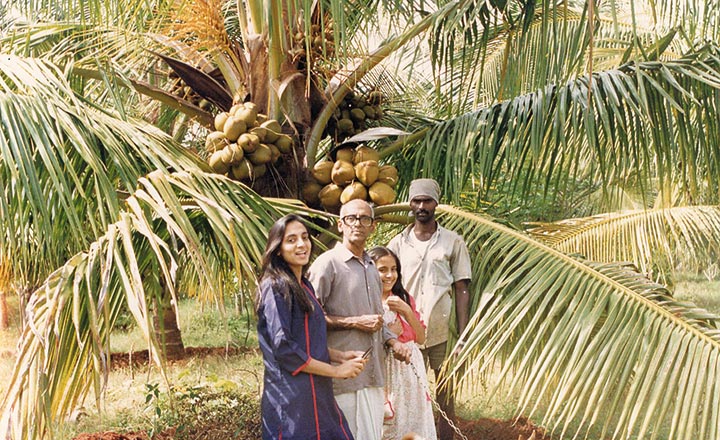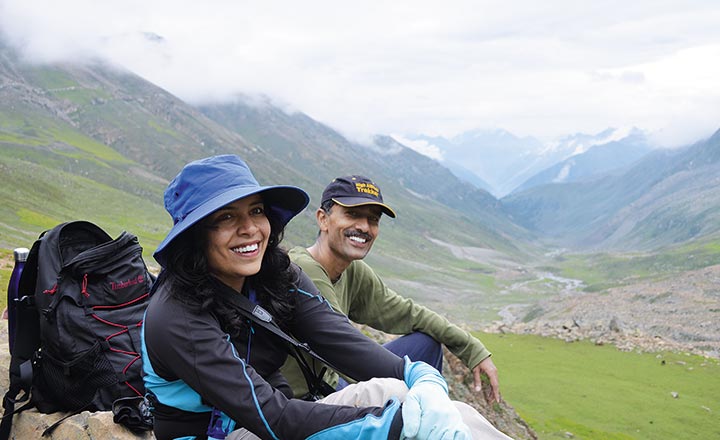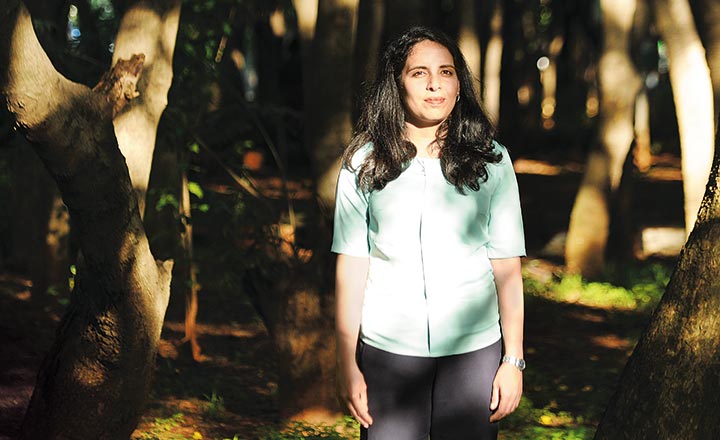Six days and some 10,000 ft later, it is only human that you feel the strain in your leg muscles. The shoulders aren’t forgiving either but it all gets overshadowed by your racing heartbeat. For, there can’t be a better reward than to see yourself finally reaching the summit. Set aside all the physical pain, the victory of overcoming the challenge you set for yourself is a feeling unparalleled. Something 36-year-old Sandhya Chandrasekharayya has experienced countless times as she conquered mountain after mountain. And having witnessed a moment so majestic, it was only natural that the former software engineer decided to turn her passion into her profession. “It’s important to have a career in something that is meaningful to you, not something that you want to retire from,” says the woman, who co-founded what is known as India’s largest trekking community, Indiahikes.
The seeds for the same were sown way back in her childhood when she grew up alongside her backyard farm in Mysuru. “My father was an English professor but he was very interested in tending to our farm. It’s there that I developed this fondness for being outdoors,” she recalls. What further acquainted Chandrasekharayya with her future hobby was her elder brother’s first trek. That’s how the fantasy to one day explore a hidden landscape was formed and being an active member of the National Cadet Corps at school gave her that opportunity over several field trips. Then came the unexpected visit to Uttarakhand, in class 7 where, hearsay about the famed Valley of Flowers, made her determined to one day return for a trek.
Preparing for the climb
Once back in her hometown, a local trek was always part of long weekends when her course work at the National Institute of Engineering allowed it. After she earned her computer science degree, Chandrasekharayya moved to the neighbouring city of Bengaluru and secured a job as a software engineer at IT services firm, Mindtree in 2003. From here she moved on to America Online (AOL) and soon enough formed a community of like-minded colleagues, “I bonded well with people who would go on treks. We hiked across several local trails such as the Sakleshpur railway trek, then we went along the Western Ghats.” It was along one such trek that love blossomed between Chandrasekharayya and her future husband, Sandeep Janardan, whom she introduced to the joys of trekking over several such weekend group excursions.
Despite the frequent local hikes, she continued to harbour a desire to embark on a Himalayan adventure. “Ever since that class 7 trip to Uttarakhand, I had developed this ambition to go to the Himalayas. And the Valley of Flowers trek was the first one I wanted to explore.” And that’s exactly what she did right after she got hitched in 2006, she giggles. “It stretches for maybe 8 km wide, the flowers appear in layers and you have a sweeping view of the valley, with a cavernous glacier in the distance that feeds the pristine river flowing through. It’s an experience that is extremely satisfying,” she describes. Post her first tryst with Himalayan terrain, Chandrasekharayya browsed several travel blogs and portals to plan the next trek. That’s when she stumbled upon a problem that would form the crux of her future start-up.
The trekking enthusiast had mapped several trails across the country but with trip costs amounting to Rs.100,000 and not much information available, she couldn’t begin ticking them off her wish list. That’s when she came across a blog titled Indiahikes that had details about a trail in the hilly mountains of Uttarakhand again, called Roopkund. There she found everything she needed to know about that particular region, what to expect in terms of scenery, detailed pointers on getting there and much more. This prompted her to simply enter a request to tag along with someone else who’d want to explore the place, and she received a positive response from none other than the blog admin himself. Arjun Majumdar, an experienced trekker, ran an English learning centre in Bengaluru then. This he did alongside documenting several unexplored and popular trekking regions in India.

Having found a group to accompany and add one more name to her list of Himalayan trails, Chandrasekharayya set out for Roopkund in 2008. Over the next week, she not only climbed 16,000 ft but found herself interested in Majumdar’s project of raising funds to organise more such treks and thus document these trails for the blog. “He informed me that there were a lot of people who were interested in Himalayan treks but there isn’t much information out there. Through the blog, he sought to collect more such enthusiasts, raise money to organise future trips and thus update the blog. Developing a trail takes a while, as the infrastructure and logistics might not be in place. It interested me and I volunteered to be a part of it but nothing more than that as I had a job then,” she says.
But, destiny had more serious plans for Chandrasekharayya. Soon after she returned from the trek with Majumdar, the duo got cracking on ways to popularise the blog. Within a few months, they managed to bring together a group of 18 people and raised Rs.9,000 from each of them. Post that, Indiahikes, which was just a travel blog, had 150 people signing up for more trips to Roopkund. “Indiahikes was nothing at that point in time, we were nobody. But our focus was to provide as much information as possible so people would find us credible. And that’s what made those 150 people sign up,” she explains. It took another four to five such successful treks for the founding duo to realise that they were in business and it was time to turn the blog into an enterprise.
Long road ahead
Chandrasekharayya and her partner had it all figured out by June 2009. They would meet up in their spare time and chalk out plans for the next trek. In addition to writing code at her day job at AOL, the budding entrepreneur was doing the same to ramp up Indiahikes’ website, spread the word via online marketing and getting more people to sign up. “It was difficult but I managed to balance it well for a while. Meanwhile, I had informed my team at AOL that I wished to move on and they suggested splitting my time between the two companies. But, I believe that if you want to grow something then you must give it your 100%, otherwise it doesn’t work,” she describes her clarity in thought then.

By January 2010, Chandrasekharayya had quit AOL and worked in a tiny room in Majumdar’s home to build Indiahikes. The start-up was doing fine for about six months till heavy rainfall on their only trek offering in Uttarakhand delivered their first business challenge. “This happened in September 2010, we hadn’t foreseen this. It was out of our control but we had taken money from people for the trek, the only right thing to do was return the money. So we pulled on somehow till October and refunded the fees. We had also hired two to three trek guides. These were people who had completed a mountaineering course. But we couldn’t pay their salaries, so we had to let them go by November,” she recalls. “We stopped drawing salaries ourselves from Indiahikes but we kept at it. The first few successful batches showed us that our model worked. We just had to figure out other trails that would help us tackle the seasonal issue.” And that’s how Indiahikes introduced its first winter trek to Kedarkantha. Today, it runs six such profitable winter trails among its 30 identified treks. Indiahikes now employs 60 people, has popularised the concept of sustainable trekking and has encouraged environmental-friendly initiatives such as Green Trails (managing waste in the hills), equipping campsites with solar lamps and monitoring the consumption of water and other resources during a trek.
Despite trying to run a business that on one hand makes money and on the other fulfills the founders’ vision of an ethically-run company, issues cropped up time and again. And Chandrasekharayya seems to have only emerged stronger from each of them. She recalls one such incident, “Indiahikes earlier would organise treks to Chadar, in Ladakh, which is a hugely popular trail. Compared to what is arranged by other tour operators for a fortune, we would accomplish the same at half the cost. But that didn’t sit well with the organisers there who claimed our costing was too low. Soon enough, the rivalry turned into a bad working environment and we decided to discontinue the trail.” Turns out this incident only ended up benefitting Chandrasekharayya’s team for it led them to discover a couple of more unexplored trails in Jammu & Kashmir. She concludes, “Sometimes when things don’t match your principles, you must not go ahead with it.”
Chandrasekharayya reiterates how this learning has defined her entrepreneurial journey so far. “I knew right from the beginning that we had a prototype that worked. We wanted to organise affordable treks for the Indian middle class unlike other tour operators who catered to the Western crowd alone.” The passionate trekker, who suffers from an autoimmune disorder, finds herself most at peace when she is up in the mountains. The number of treks she participates in may have reduced to only three, but that’s because Chandrasekharayya is focused on building an organisation that scales newer heights. While she is cognisant of the need to maintain a healthy bottomline, she reveals how monetary aspects often take a backseat. “We’re here to do something bigger, business at any cost is not our motto”.











